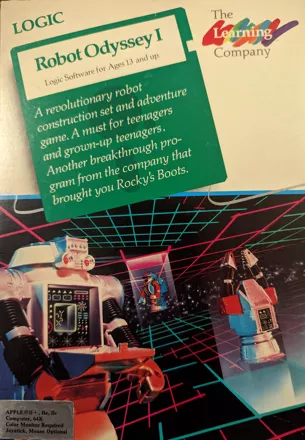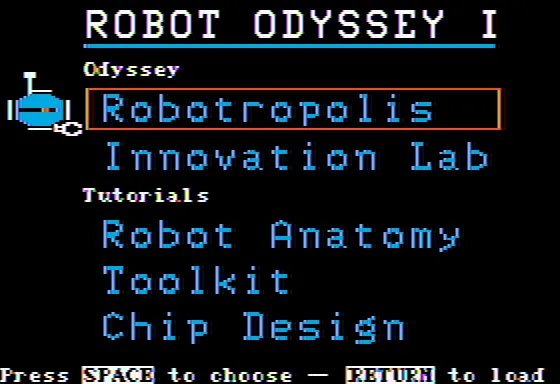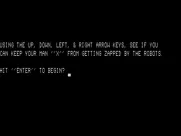Robot Odyssey
Description official description
Robot Odyssey is a logic adventure game. You have been taken into Robotropolis, an underground city of robots. To escape, you must program your robot helpers Sparky, Checkers, and Scanner to solve the puzzles and escape.
Screenshots
Credits (Apple II version)
27 People · View all
| Authors | |
| Director | |
| Lab Designer | |
| Game Designers | |
| Tutorial Designers | |
| Manual Writer | |
| Production Manager | |
| Editor | |
| Game Graphics | |
| Title and Manual Graphics | |
| Musician | |
| Title Animator | |
| Reviewers | |
| [ full credits ] | |
Reviews
Players
Average score: 3.9 out of 5 (based on 24 ratings with 3 reviews)
The absolutely best educational game every made!!!
The Good
This game was the best educational game I have ever seen. I played this game when I was elementary school age, and little did I know I would use the same logic many years later in a high school digital electronics class.
The Scoop In this game you are a little character that has three (and later four) robots that you can “wire” to solve the puzzles to get you out of the land you are lost in “Robotroplis.” The robots have a) four bumpers that “heat” a wire when touching walls, b) four thrusters that when “heated” move the robot around the screen, c) an antenna that when “heated” sends a signal to the other robots, d) a grabber that when “heated” picks things up, e) an on off switch so it can be used or not, and f) set amount of power that gets used up. The wires are “heated” using digital gates (And, Or, Xor, and Not, and FlipFlops) that send electric signals through the wires. Using a tool box full of these gates and other items found in the game you wire up the robots to move around, pick things up, put things down, send signals and a combination of all these things to solve puzzles. The robots, if turned on, then respond when you turn on your remote.
Tutorials There were many tutorials that went through very detailed how to play the game. From exactly what keys to press, to how each gate was used, to how each part of the robots functioned. I was shown how to play from my dad and brothers so I didn’t do th tutorials until much later, I went through them just to say I did.
The first level In the first level you start with three robots. They each are already wired to solve all the puzzles on the first level, this giving you a basic idea of the uses of the gates and how they work with the robots. One robot has a flipflop that changes so the robot moves up or down changing direction when it hits a wall. (I must mention that the flip-flop functions slightly different than in real digital electronics, but basically the same so it gives the idea of digital electronics anyway.) Another robot is wired using a pre-designed chip to “hug” the walls. The third robot, if I remember correctly, was wired to detect things. You must collect a few things including a spare power crystal, before progressing to the next level.
Level Two In this level you must take control of the robots, mainly focusing on the flip-flop and thrusters to move you through some repetitive tasks, this was the most boring level, but important to get you familiar with wiring and re-wring the robots. As you repeat several tasks you are able to move through multiple areas and pickup more objects to help you later.
Level 3 Now my brain gets forgetful, but I believe this one focuses on the use of the antenna and grabber, and you start learning to use multiple robots to accomplish the tasks. The first time I played the game I couldn’t get past the last puzzle on this level, which required the use of the antenna. When I learned how that was used I was able to pass this level the second time I really played the game.
Level 4 This one you must free a fourth robot to help you. You do this by solving four puzzles which take two to three of the robots to solve each one. These took me the longest the first time I played (I never was able to finish level 5 the second time I played) One of these puzzles was a minefield maze where your robot couldn’t touch the walls. The maze was invisible, but luckily there was a version of the maze where you could see the walls and prepare for it. Another one was a maze you could see, but had to bounce around a lot to get through. A third task included using the robot to push a button that kept moving. And the hardest one was using the robots to go through specially colored lines each robot could only pass through a certain color.
Level 5 With four robots now you have to use major teamwork to accomplish all sorts of goals. The most notable that I didn’t get past the first time I played and a couple years later was able to pass was a timing circuit. Unlike in real life, the electricity flowed very slowly through the wires and gates. On one puzzle you had to wire it so that the electricity would be timed just perfect to broadcast a beep on the antenna to the beat of the puzzle. Another really hard puzzle on this level was the last one. You had to time all four robots to push eight buttons in sequence. Obviously each robot had to push two buttons but the way they were spread around the screen each robot had to hit one button before the any could hit the second button. I remember well the third time I played and was able to finish all the puzzles was a new years eve, and I stayed up all night, I think I was in sixth grade about this time.
Innovation Lab
In addition to the game there was a part where you could be creative and design your own puzzles or test redesign puzzles found in the game to test your circuits on. If the circuits were too complex to do with the limited number of gates given, you could wire them inside a prototype chip that you could then burn to another chip. There were up to eight chips that could be used, and these could also be used in the game.
The Bad
There was nothing I didn’t like about this game. Being now 2003 I could say the graphics are noticeable 1985 style, but in 1985 the CGA (4 color) was good for a PC, much better than the text based games of previous years.
The Bottom Line
Highschool level digital electronics for much younger children! I wish they would make a sequel.
DOS · by Nathan Tyler (4) · 2003
Robot Odyssey is an educational classic.
The Good
I love the fact that the game is both a fun adventure and a learning experience. I also think that the sophistication of the player programming is impressive for such an old game. There are also some great tutorials which explain how to program the robots using logic gates.
The Bad
This PC version didn't look too good with it's CGA graphics. The earlier apple version looked better.
The Bottom Line
The player must program their robot helpers to solve various puzzles. The programming involves "soldering" electrical circuits inside the robots. It's LOTS of fun, and truly imaginitive. It is also surprisingly difficult. There still hasn't been any game like this one.
DOS · by Ben Sokal (15) · 2000
This is the most challenging game I've *ever* played.
The Good
In Robot Odyssey, you find yourself lost in the world of Robotropolis. At your disposal are three robots - Sparky, Scanner, and Checkers. Using your trusty soldering iron and toolbox full of logic gates (AND, OR, XOR, and NOT), you must continually rewire the brains of your robot friends to help you escape.
Many of the puzzles in Robotropolis are "hands-off". That is, your character cannot actually wander into the room that contains the puzzle. Instead, you need to program your robots to solve the puzzles for you. Some of the early puzzles can be solved by a single robot, and you're allowed to ride around inside the bots and rewire them on the fly. But many of the later puzzles require you to program all three robots to communicate with each other (using antenna pulses) to carry out small portions of a singular greater task, and you can't interfere once they enter the puzzle area. So once you set them in motion, you'd better hope your circuit designs work - otherwise, you lose your robots FOREVER! (Or, until you reload a saved game.)
Oh, did I mention that you also need to program your robots to come back to you once they solve the puzzle?
To me, there was something that was unbelievably cool about making these little robots do tricks. You have absolute freedom in how you wire your 'bots. I'll always remember how I felt when I finally figured out how to solve the "Form-12 Vending Machine" puzzle on Level 3 (a "hands-off" puzzle requiring communication, teamwork, and timing between at least two robots).
Another nice feature about this game is that it's actually two "games". One aspect of it is "Robotropolis", which is the actual "game" part.
The other aspect is the "Innovation Lab". It's basically a sandbox for you to test out new circuit designs for your robots. You have a prototype microchip that you can rewire arbitrarily, and then burn onto smaller chips. These smaller chips can be saved into the game's Chip Library, so you can use them at any time during the "Robotropolis" part of the game.
Here's an example of the Innovation Lab - In at least one Robotropolis puzzle, two robots had to navigate copies of a maze, each in a seperate room. One room was the "map room", which was basically a maze where a robot could bounce around off the walls as it liked. But the second room was the "minefield" room. Not only were the maze walls invisible in this room, but if a robot touched them, it would have its battery drained, and its circuits wiped clean, effectively becoming "dead". And since your character can't actually enter the minefield room, if your robot gets fried, it's effectively out of the game. I remember spending a week in the Innovation Lab desigining a specific microchip that could be used in both robots to solve this particular puzzle. Using this chip, the "guide" robot in the map room would "know" that it was the guide, and it would broadcast periodic guidance signals over its antenna. The robot in the "minefield" room would "know" that it was in the minefield, and it would react to the signals accordingly to change its movement vector to avoid the deadly invisible walls.
That was just damn cool.
There's a large area of the Lab that has mutable walls. By changing your cursor into paintbrush-mode, you can add or remove walls in this area as you choose. The ability to "paint" your own walls comes in quite handy, since you can effectively replicate any Robotropolis puzzle within the Lab this way.
The Bad
Once you hit Level Four in this game, the puzzles become devious. They were certainly beyond my abilities, as a kid. I've recently found a copy of this game, and I've been replaying it over the past week - I was able to blow through all of the puzzles up to Level Four. Some of them were quite a challenge - even some of the puzzles on Level Five are easier.
I suppose, this being the year 2003 and all, I should make some remarks about this game's graphics and sound. They're craptacular. CGA, and PC speaker beeps. It's not a first person shooter. Hell, in early versions of this game, your character didn't look like a goofy little person -- he looked like a white square.
But you know, this is one of those games that doesn't need to look cool, to be cool.
The Bottom Line
How would I describe this game to others? Simple:
Nineteen years ago, when I was around 7 or 8 years old, my mom bought this game for me in an attempt to teach me about logic. "Well, okay. Computers are kinda boring and intimidating, but I guess robots are neat," I said.
I ended up playing the hell out of this game as a kid, because I loved teaching my little robots to do tricks.
Today, I'm a computer programmer. I love teaching high-powered servers to do tricks.
DOS · by Dave Schenet (134) · 2003
Trivia
Sequel
The title screen for the game says Robot Odyssey I and the manual also says Robot Odyssey 1, which implies that a sequel was intended. Unfortunately, there was none. While no sequel was released, Rocky's Boots by the same company can be considered a prequel in many aspects.
Information also contributed by Mike Kienenberger
Analytics
Upgrade to MobyPro to view research rankings!
Related Sites +
-
Droid Quest
History of Robot Odyssey, credits, instructions, and a complete freeware re-implementation in java that includes expanded features (better chip lab which can now be used to build an n-bit computer in-game, level editor, and more) -
Fractal101's Robot Odyssey Page
This page contains solutions to the Robot Odyssey puzzles, screenshots, and information on how to play Robot Odyssey.
Identifiers +
Contribute
Are you familiar with this game? Help document and preserve this entry in video game history! If your contribution is approved, you will earn points and be credited as a contributor.
Contributors to this Entry
Game added by Ben Sokal.
TRS-80 CoCo added by Tess. Apple II added by Mike Kienenberger.
Additional contributors: Mike Kienenberger, Alaka.
Game added June 13, 2000. Last modified August 30, 2023.










